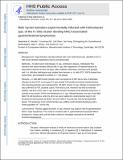Male Syrian Hamsters Experimentally Infected with Helicobacter spp. of the H. bilis Cluster Develop MALT-Associated Gastrointestinal Lymphomas
Author(s)
Woods, Stephanie; Ek, Courtney; Shen, Zeli; Feng, Yan; Ge, Zhongming; Muthupalani, Sureshkumar; Whary, Mark T; Fox, James G; ... Show more Show less
Downloadnihms-710251.pdf (983.2Kb)
OPEN_ACCESS_POLICY
Open Access Policy
Creative Commons Attribution-Noncommercial-Share Alike
Terms of use
Metadata
Show full item recordAbstract
Background: Aged hamsters naturally infected with novel Helicobacter spp. classified in the H. bilis cluster develop hepatobiliary lesions and typhlocolitis. Methods: To determine whether enterohepatic H. spp. contribute to disease, Helicobacter-free hamsters were experimentally infected with H. spp. after suppression of intestinal bacteria by tetracycline treatment of dams and pups. After antibiotic withdrawal, weanlings were gavaged with four H. bilis-like Helicobacter spp. isolated from hamsters or H. bilis ATCC 43879 isolated from human feces and compared to controls (n = 7 per group). Results: Helicobacter bilis 43879-dosed hamsters were necropsied at 33 weeks postinfection (WPI) due to the lack of detectable infection by fecal PCR; at necropsy, 5 of 7 were weakly PCR positive but lacked intestinal lesions. The remaining hamsters were maintained for ~95 WPI; chronic H. spp. infection in hamsters (6/7) was confirmed by PCR, bacterial culture, fluorescent in situ hybridization, and ELISA. Hamsters had mild-to-moderate typhlitis, and three of the male H. spp.-infected hamsters developed small intestinal lymphoma, in contrast to one control. Of the three lymphomas in H. spp.-infected hamsters, one was a focal ileal mucosa-associated lymphoid tissue (MALT) B-cell lymphoma, while the other two were multicentric small intestinal large B-cell lymphomas involving both the MALT and extra-MALT mucosal sites with lymphoepithelial lesions. The lymphoma in the control hamster was a diffuse small intestinal lymphoma with a mixed population of T and B cells. Conclusions: Results suggest persistent H. spp. infection may augment risk for gastrointestinal MALT origin lymphomas. This model is consistent with H. pylori/heilmannii-associated MALT lymphoma in humans and could be further utilized to investigate the mechanisms of intestinal lymphoma development.
Date issued
2016-05Department
Massachusetts Institute of Technology. Division of Comparative MedicineJournal
Helicobacter
Publisher
Wiley Blackwell
Citation
Woods, Stephanie E. et al. “Male Syrian Hamsters Experimentally Infected withHelicobacterspp. of theH. bilisCluster Develop MALT-Associated Gastrointestinal Lymphomas.” Helicobacter 21, 3 (September 2015): 201–217 © 2016 John Wiley & Sons Ltd
Version: Author's final manuscript
ISSN
1083-4389
1523-5378